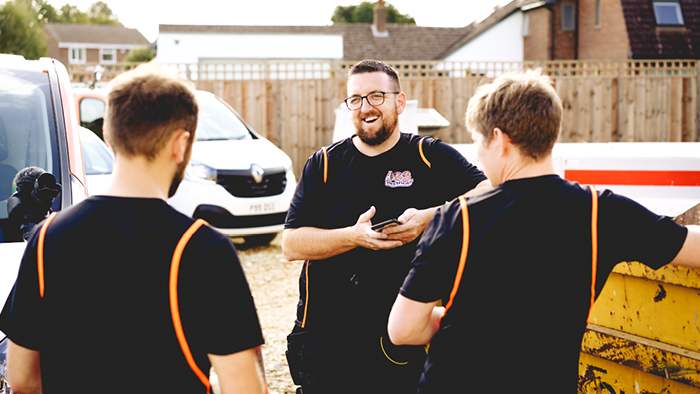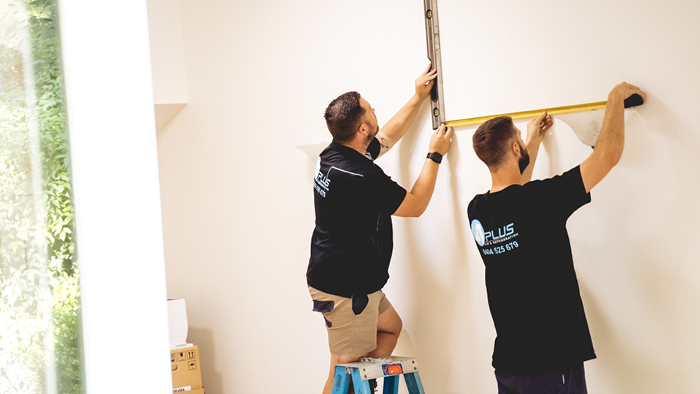Different Types of Building Materials and Their Uses
by Team Tradify, January 7, 2025

Table of Contents
The world of building materials is vast and the options are nearly endless, no matter which trade you’re in. Ultimately, choosing the right building material for your project comes down to what will give you the best result, but knowing where to start can be daunting.
Check your business is set up for success with our free Profit Margin Calculator!
To make things easy, we’ve compiled a comprehensive list of go-to materials, from construction to HVAC, electrical to landscaping — as well as recommendations on where to use each material.
It’s a big list. You can jump ahead here:
- Building and construction materials
- Electrical wiring materials
- Plumbing materials
- Landscaping materials
- HVAC and gas installation materials
- Getting bang for your buck – adding margins to materials
- Materials for every trade
1. Building and construction materials
Cladding, roofing, flooring and framing are the bones of any building project. The most common materials in construction are steel, concrete, wood, stone, brick and masonry. But that’s just the beginning. Here’s the full rundown:
Cladding
Cladding serves as a base layer for a building, providing structural walls with insulation and protection from moisture and weather changes. When it comes to your cladding options, there’s a fair few to choose from.
Brick
Known to withstand the test of time through tough conditions, brick has been used for centuries and is a reliable solution for most projects. Bricks can be labour-intensive and time-consuming, but they’re usually an affordable option.
Timber and weatherboard
This is a low maintenance option that gives you a tidy finish. Timber also has great heat and sound properties, as well as optimal durability. What’s more, it’s a great sustainable building material option as wood is a renewable resource.
Stone
Stone has solid structural strength and is an excellent insulator. With a rustic and natural appearance, stone cladding is often chosen to be a feature of a home, such as in entranceways, pillars, or walls.
Metals
The metal cladding bracket includes a few options, such as steel, zinc and copper. Though it might come with a higher price tag, metal is one of the most durable cladding options and creates a modern aesthetic for any construction project.
However, not all metals are created equal. Since the Grenfell Tower disaster in 2017, issues have been raised about the safety of aluminium cladding, given how flammable it is. As a result of the incident, builders and contractors in the UK now must pay for renovation costs if their buildings are non-compliant, and many cladding laws and regulations have changed around the world, including in the US, Australia, and New Zealand. Although aluminium is an affordable option, it’s one to steer clear of.
Flooring
Flooring takes centre stage in construction. Knowing what best suits your project takes some thought. Here are your options:
Brick
A traditional solution that can be found in historic buildings all around the world, brick flooring is extremely durable and won’t break the bank. Because it can create an uneven surface, its best used in open spaces, to avoid wobbly furniture.
Flagstone
Because it’s extremely durable, slip-resistant and easy to clean, flagstone is typically used outdoors for pathways or around gardens.
Natural stone
The benefit of natural stone is that it can be used both inside and outside because of its durability. Natural stone is one of the most aesthetically pleasing options for floors. With many natural stone options – like marble, granite, travertine, limestone, slate and sandstone – there’s one for almost every project.
Tiles
Whether it’s ceramics, porcelain, quarry, PVC or vinyl, tiles are commonly used for floors, given their resistance to chemicals and hot temperatures. That makes them easy to clean and maintain, a great solution for kitchens and bathrooms. They’re also moisture-resistant and durable – and can handle heavy foot traffic.
Glass
Glass floors are a great option for buildings with a modern interior. Because they reflect light, glass floors can make a space feel brighter. So, what’s the catch? A glass floor will cost you – it’s considerably more expensive than other solutions on the market.
PVC
This is an affordable option with many benefits, such as being resistant to spills and chemicals and easy to maintain. Because PVC can be soft, it’s prone to scratches and may not be the most long-lasting material. It may also fade in the sunlight.
Timber
Timber floors bring character to any building. It may seem like a big investment initially, as they have a higher price tag, but if looked after, timber flooring will last more than a hundred years. Timber is also easy to maintain, and being a completely natural material, it’s a sustainable and chemical-free solution.
Cork
One of the more sustainable building materials for floors, cork is biodegradable and will break down in the earth if it’s disposed of properly. But that doesn’t mean it’s a flimsy flooring option – because it’s a soft, natural fibre, cork is a great solution for spaces where people will be standing for long periods, like in a kitchen. It’s also good for places like aged-care facilities or childcare centres, where there’s a greater risk of falls.
Carpet
Carpet for flooring has obvious advantages – soft to walk on, quiet and comfortable. Carpet can also be an inexpensive option but comes with some disadvantages such as showing wear and tear and needing thorough maintenance to stay in good condition.
Roofing
A roof is the cherry on top of a construction sundae. The type of roofing you choose will ultimately come down to its price, durability and performance. Here are your options:
Asphalt
This is a cost-effective solution that is gaining popularity due to its resistance to rot and ease of installation. Compared to other roofing materials, asphalt doesn’t offer huge insulation and has a relatively short lifespan of around 25 years.
Clay
Clay tiles are known to be fairly durable, but they’re subject to damage in very cold temperatures. For that reason, they’re more suited to warmer climates. Clay tiles are easy to maintain and will last for more than 100 years if looked after.
Concrete tiles
Concrete is very durable and will last between 30-50 years when cared for properly. It can withstand extreme hot or cold temperatures, but because it’s heavy and has a high absorption rate, it can add a lot of weight to a roof when it rains. This can make concrete tiles more difficult to maintain.
Copper
Copper is resistant to fire, mildew or hail, and with regular maintenance can last upwards of 50 years. Because it’s so lightweight, copper is a great solution for homes that can’t afford to have added weight stress – such as climates with heavy snowfall. On its own, copper isn’t the most soundproof material, so another sound-absorbing material would need to accompany it underneath.
Corrugated steel
The benefits of a corrugated steel roof are many – it’s durable and will withstand the toughest of conditions, making it ideal for areas prone to intense weather such as hail storms. It’s also lightweight, and when taken care of, can last up to 100 years.
Solar tiles
If you’re after a material that’s good for your home, the planet and your pocket, solar tiles are the way to go. You’ll save money on your energy bill and may even earn some with the excess power your panels send back to the grid.
Thatch
Thatch provides excellent insulation, keeping a building cool in the summer and warm in the colder months. It also lasts more than 60 years when maintained. Plus, the aesthetics of a thatched roof add a huge amount of character to a build. So, what’s the hazard? It can be a fire risk, and extra maintenance is required to ensure optimal safety.
Green roofs
As the world turns to more sustainable building solutions, there’s never been a better time to introduce a green roof, covered with plants and vegetation to help filter the air by releasing oxygen and absorbing carbon dioxide. A green roof comes with environmental advantages, but carries a slightly higher cost and requires increased maintenance.
Framing
As a building’s ‘skeleton’, framing plays a pivotal role in protecting and supporting the interior and exterior of a structure – so it’s important to use the best materials.
Timber
A sustainable and completely natural material, timber has many benefits for your framing. It is resistant to rust, naturally insulating and not a natural conductor – which means even when the weather gets hot, timber framing will remain cool.
Steel
Steel is one of the most structurally stable materials to use for framing. Because it doesn’t absorb moisture, there is a lower risk for long-term moisture retention. Steel is also fire resistant but it can rust – and isn’t the best insulation solution.
Precast concrete slabs
Precast concrete panels are a cost-effective solution that provides strength and durability against things like impact, corrosion and acids.
Insulated concrete forms (ICFs)
Dubbed the strongest and most airtight type of framing available, ICFs are gaining popularity for their fire resistance and durability – even in the most extreme weather conditions.
Concrete masonry units (CMUs)
CMUs are resistant to fire, moisture, pests and extreme weather conditions. The downside is their low insulative properties, which impacts a building’s eco-footprint.
Check you've set your margins properly with our free Material Markup Calculator!

2. Electrical wiring materials
House wiring is very important to get right. Poor installation or lack of maintenance can lead to electrical fires. Good electricians take great care in installing electrical wires and cables – always using the correct materials for the job.
Cleat wiring
Comprised of PVC insulated wires or ordinary VIR braided and compounded, cleat wiring is held on walls and ceilings using porcelain cleats with groves, wood or plastic. It’s a temporary wiring system, making it unsuitable for domestic premises. You’ll find that these systems are rarely used these days.
Casing and capping wiring
A popular option in the past, casing and capping wiring is considered obsolete these days because of the popularity of other systems. The cables used in this electric wiring were PVC, VIR or any other approved insulated cables. The cables were carried through the wooden casing enclosures, made of a strip of wood with parallel grooves cut lengthwise for accommodating the cables.
Batten wiring
This is when a group of wires are laid over a wooden batten. The wires are held to the batten using a brass clip and spaced at an interval of 10 cm for horizontal runs and 15 cm for vertical runs. Batten wiring requires much less material to install than other systems.
Lead sheathed wiring
A type of batten wiring, lead-sheathed wiring uses conductors insulated with VIR and is covered with an outer sheath of lead aluminium alloy (which contains about 95% lead). The metal sheath protects cables from mechanical damage, moisture and atmospheric corrosion.
Conduit wiring
There are two types of conduit wiring: surface and concealed. When GI or PVC conduits are installed on walls or the roof, it is known as surface conduit wiring. When the conduits are hidden inside the wall slots or chiselled brick wall, it is called concealed conduit wiring.
Both types are reliable and safe from chemical effects, humidity and other external factors. There’s also minimal risk of wear and tear, fire, damage or shock. But, it can be a slightly more expensive option — installation is complex and it’s difficult to spot defects.
3. Plumbing materials
A plumber’s job is all about pipes and fittings. But as technology develops, there are different types of materials used for pipes. Here are the pros and cons of each.
PVC
PVC (polyvinyl chloride) is a favoured material because of its affordability, rust and corrosion resistance, and ease of installation. But there are a few drawbacks: PVC doesn’t handle heat well and will break down if the temperature is too hot.
There’s also a safety concern with using PVC for drinking water, as toxins can be released if it’s exposed to the sun.
Another PVC solution is CPVC, which is the same material but with chlorine added. CPVC has all the pros and cons of regular PVC, but the added chlorine allows it to handle higher water temperatures, which often makes it the more favoured option of the two.
PEX
PEX, otherwise known as cross-linked polyethylene, is much the same as PVC, with the added advantage that it’s flexible and easy to cut and join. With similar properties to PVC, PEX has similar pros, like being low-cost, easy to use and the added advantage of being heat resistant.
The downside is that PEX pipes have been known to affect the taste of water, and possibly its safety.
Copper
Copper is a traditional pipe material and is still popular in modern homes. It has natural antibacterial, antiviral, and anti-fungal properties. Copper can last up to 50 years, and when it eventually needs to be replaced, can be fully recycled – making it a great eco-friendly building solution.
Copper is also known for its durability and resistance to leaks and corrosion, and its ability to handle extreme hot or cold temperatures. The only downside to copper is that it is on the more expensive side of piping materials.
Galvanised steel
These are steel pipes that have been coated in zinc to prevent rust and corrosion. However, it’s not often a success and rusting still happens quite easily. There’s also a risk of lead contamination if pipes become corroded, and there’s a higher risk of clogging from mineral build-up.
Galvanised steel pipes were popular before the 80s but given their long list of disadvantages, it’s advisable to replace any with more modern material.
Cast iron
Cast iron was a popular piping material before the 21st century because of its durability, strength and heat resistance. The disadvantage is that cast iron is susceptible to rust over time, can easily clog or slow drains and can involve messy repairs if something goes wrong.
4. Landscaping materials
As a landscaper, you need to have a sound understanding of the sturdiest materials for your projects, but you also need to have an eye for aesthetics – and choose materials based on their visual appeal.

Concrete
A versatile landscaping material, concrete can be used on patios, paths and fences. Although it boasts great durability and strength, concrete shouldn’t be used in areas where the ground may move – such as around the base of a tree.
Brick and rock
Brick and rock are durable and require low maintenance. Use bricks or rock for paths, fences or garden edges.
Asphalt
Another reliable go-to, asphalt is commonly used in landscaping projects. Asphalt can be damaged by heat and sun which affects its water resistance , so any cracks or potholes should be sealed as soon as possible to avoid further damage.
Stone
Stone is another durable option with a natural, rustic appearance, popular across different parts of a landscaping project. The downfall with stone is that it has less moisture retention for the soil underneath it.
Sand
As a smooth surface, sand is the perfect material for spaces like children’s play areas. The obvious downside to sand in an outdoor environment is the mess carried inside.
Wood chips
Wood chips add an earthy element to an outside space, and they come with a host of benefits. They help with water retention, so you don’t have to water plants as often. They’re also an eco-friendly solution because they break down naturally over time, adding goodness to a garden.
Greenery
Trees and plants are the obvious choices for decorating an outside space. What’s gaining more popularity recently are living fences – made up of plants next to each other. Not only do live fences tick the aesthetic box, but they’ll also last forever if managed properly.
5. HVAC and gas installation materials
From materials that have been around for centuries to a few new additions, here’s our list of HVAC and gas installation materials.

Fibreglass
This material has been used in the industry for decades. It’s known for its moisture and fire resistance, and easy installation. It’s also great for technicians looking for sustainable solutions as it’s made from a combination of recycled and renewable materials. The downside to fibreglass is its low energy efficiency and insulation properties.
Spray foam
Spray foam provides excellent insulation and is popular for its structural strength and moisture resistance. There are three types of foam used in the HVAC and gas industry:
- Crushed foam – generally used to fill gaps in HVAC units.
- Open-cell foam – used to dampen sound, filter air or for thermal insulation or cushioning.
- Closed-cell foam – used for sealing by reducing liquid and gas flow.
Metals
The main metals used in HVAC and gas are copper and steel. Copper is a great option because of its durability, resistance to corrosion and ability to handle high temperatures.
Steel is the more affordable of the two, and it can also handle higher pressures than copper. For that reason, copper is generally best for smaller pipes, and steel for bigger parts.
Plastic
There are two types of plastic commonly used for HVAC and gas – PVC and CPVC. Plastic options are popular because of their affordability, but they can’t handle as much heat as alternatives like metal, which makes them ideal for use for gas ventilation rather than hot liquids. Plastic materials are generally much weaker than metals, meaning they’re unable to take as much pressure.
6. Getting bang for your buck – adding margins to materials
Once you’ve chosen the materials for your project, you need to figure out what to charge for them and set your margins. Your margin is the difference between what you get paid for a job and what it costs you to do that job – including the cost of materials. If you set your margins too high, you’ll struggle to secure work. But set them too low and you’ll miss out on profit.
So, how do you decide on an appropriate margin for your materials? That all comes down to your business circumstances. Don’t make the mistake of not adding an appropriate margin and wondering where all your profit has gone. Some tradespeople agree that 10% is fair, others consider 5% to be steep.
As a tradesperson, you need to calculate your margins to find that sweet spot in the middle. For a bit of extra help, check out our guides:
7. Materials for every trade
Whether you’re in the building, landscaping or plumbing industry, the list of materials available for your projects is long. What you choose to use ultimately comes down to strength, durability and ability to stand the test of time.
Ready to take control of your business?
Keep track of the cost and quantities of materials used in a project with Tradify. Start your free 14-day trial today or book a free demo.
Related articles

Quick Quotes Mean More Jobs for Sharp Air Conditioning

How To Set Up a Google Business Profile (for Trade Businesses)

Aussie Electrician Reduces Admin Time by 95%
Give Tradify a go for free!
Save 10+ hours/week on business admin with the highest-rated job management software for tradespeople.
With free one-on-one training and phone support, it's never been easier to get started.





